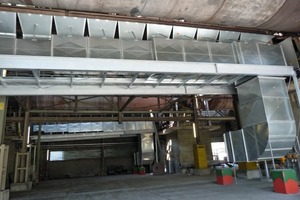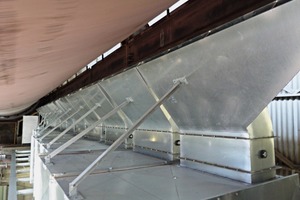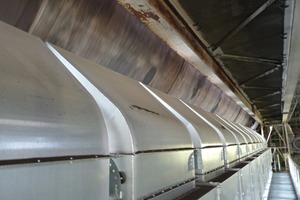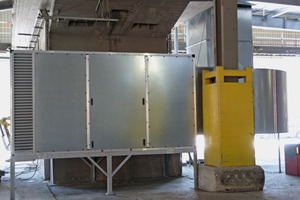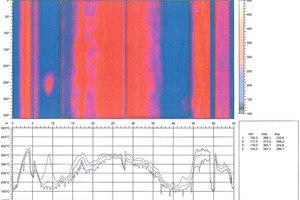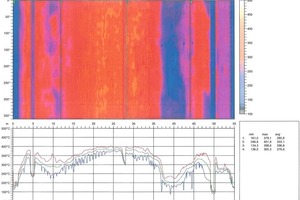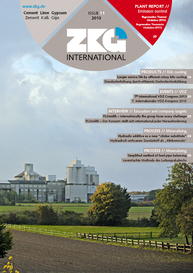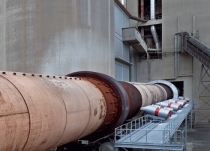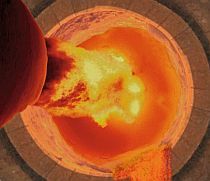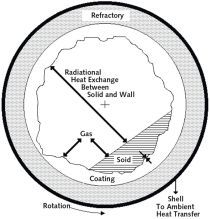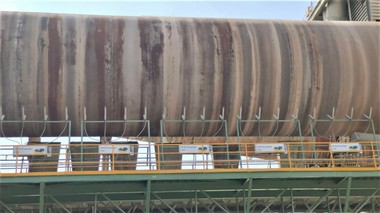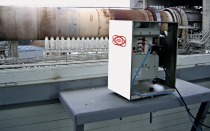Longer service life by efficient rotary kiln cooling
The main factors responsible for this were unstable coatings in the rotary kiln (frequent coating collapse) and the significantly thinner layer of coating than that formed when only operating the firing system with primary fuel. The kiln shell temperatures were consequently very much higher, particularly in the central clinkering zone – sometimes reaching peaks of up to 450 °C. In addition to the kiln shell, the refractory lining was also subjected to extreme stresses.
One method of alleviating such kiln lining stresses is to cool the surface of the kiln shell. For this purpose, axial fans with outlet nozzles are often employed. These fans are mounted on the kiln. However, if a number of axial fans are installed side by side, this generally results in a considerable noise emission.
To prevent this noise generation, Rippert Anlagentechnik of Herzebrock-Clarholz/Germany has developed a special cooling system. By means of a new, large-area kiln shell cooling system, the coating conditions are stabilized and the service lives of the refrac-tory lining and the kiln itself are increased. This kiln shell cooling system primarily regulates the temperatures in the area between the middle supporting roller station and the outlet-end roller station – the clinkering zone.
In order to achieve a significant cooling effect, a 17 metre long collecting duct fitted with cooling nozzles was installed along each kiln axis (Fig. 1). The distance between the nozzles and the surface of the kiln shell is approx. 300 mm, which enables a very good cooling effect to be achieved. The short distance between the individual cooling nozzles (approx. 50 mm) guarantees a uniform supply of air over the entire cooling zone (Fig. 2). The fluidic design of the duct system assures uniform exit velocity at the cooling air nozzles. To hold the duct system, a special supporting structure with walkway was installed (Fig. 3).
The air is supplied by two axial fans with an impeller diameter of 1600 mm and a drive power of 45 kW. With each of these axial fans, 130 000 m3 of air per hour is uniformly distributed over the surface of the kiln shell. To reduce their noise emission, the axial fans are equipped with an intake air silencer and an exhaust air silencer, and are assembled as a compact unit (Fig. 4). By means of butterfly dampers installed in the individual nozzles, the supplied air can be throttled to the desired velocity (max. 20 m/s), and specifically delivered to the area of the kiln shell that requires cooling. In this manner, the cooling system can be adapted to changing requirements.
After the first commissioning in April 2012, the described large-area kiln shell cooling system resulted in entirely satisfactory measurement. Within a very short time, temperatures fell by an average of 50 °C over the entire area (Fig. 5). As a result, the coating in the rotary kiln has become significantly more stable, which is especially obvious when disturbances arise due to the operating conditions or when failures occur in the secondary fuel supply.
Finally, it has also been ascertained that the development and installation of the kiln shell cooling system has made the rotary kiln systems less susceptible to fluctuations in the fuel composition. As a result of the improved coating conditions, the stresses imposed on both the refractory lining and the kiln shell have been significantly reduced.

